
It's 10 pm and you're on-call. A few minutes ago, you received a slack message about performance issues affecting users of your application. You sigh, pour yourself some instant coffee, and start pulling up the logs of your Kubernetes cluster. By chance, you peek at the latest HTTP request coming through - it's a purchase for foot cream. Not only that, but it has the customer's name, email, and IP address written all over it.
"Ah," you think to yourself. "I probably shouldn't be seeing this."
How often in your career have you muttered these words? With so much personal data flowing through applications, it can be all too easy to chance upon sensitive information while debugging issues. Some observability tools, like Pixie, enable users to redact data sources they know to be sensitive. Unfortunately, this solution drops entire categories of data, removing information that may be useful for debugging. To prevent privacy leaks while retaining useful information, developers need a system that finds and redacts only the sensitive parts of each data sample.
Recent breakthroughs in natural language processing (NLP) have made PII detection and redaction in unseen datasets feasible. In this blog post, I present:
- An interactive demo of a PII anonymizer
- A new public PII dataset for structured data
- Privy, a synthetic PII data generator
- Benchmarks for off-the-shelf PII classifiers
- Custom PII classifiers for protocol trace data (SQL, JSON etc)
Pixie is an open source observability tool for Kubernetes applications that uses eBPF to automatically trace application requests, removing the need for manual instrumentation. Pixie supports a PIIRestricted data access mode that redacts a limited number of PII types (IPs, emails, MAC addresses, IMEI, credit cards, IBANs, and SSNs) using rule-based logic. Adding an NLP-based classifier would enable Pixie to detect additional PII like names and addresses. The Pixie project is gauging community interest in this feature request - feel free to check it out and add comments.
The costs of privacy violations have never been higher. Be it the EU's General Data Protection Regulation or California's California Consumer Privacy Act (CCPA), governments have enacted a flurry of new laws seeking to protect people's privacy by regulating the use of Personally Identifiable Information (PII). The GDPR alone charges up to €20 million or 4% of annual global turnover (whichever is greater) for privacy violations. Despite such steep fines, compliance with these laws in the software industry has been spotty at best; privacy breaches abound and companies are paying millions as a result.
With recent advances in deep learning for text classification, developers have gained a promising new tool to detect sensitive data flows in their applications. Transformer-based architectures achieve remarkable accuracy for Named Entity Recognition (NER) tasks in which models are trained to find geo-political entities, locations, and more in text samples.
Rule based approaches (including regex) can be helpful for detecting pattern-based PII data such as social security numbers or bank accounts, but they struggle to identify PII that don’t follow clear patterns such as addresses or names, and can be overly sensitive to formatting. For a generalizable PII solution, it is often better to employ machine learning.
A machine learning system is only as accurate as the data it's trained on. To have a good sense of how well a model performs, we need a dataset representative of the real life conditions it will be used in. In our case, we are looking for PII data a developer might encounter while debugging an application, including network data, logs, and protocol traces. Unfortunately, this data is not readily available - because PII is sensitive, public PII datasets are scarce. One option is to train on data leaks, though this data tends to be unlabelled, and is morally questionable to use. The labelled datasets that do exist (including 4-class Conll, and 18-class OntoNotes) consist of news articles and telephone conversations instead of the debugging information we need.
Due to the lack of public PII datasets for debugging information, I have generated a synthetic dataset that approximates real world data. To my knowledge, this is the largest, public PII dataset currently available for structured data. This new, labelled PII dataset consists of protocol traces (JSON, SQL (PostgreSQL, MySQL), HTML, and XML) generated from OpenAPI specifications and includes 60+ PII types.
The dataset is publicly available on huggingface. It contains token-wise labeled samples that can be used to train and evaluate sequence labelling models that detect the exact position of PII entities in text, as I will do later in this article.
# text, spans{"full_text": "{first_name: Moustafa, sale_id: 235234}", "spans": "[{value: Moustafa, start: 14, end: 21, type: person}]"}
Each sample was generated from a unique template extracted from a public API.
# template{"first_name": "{{person}}", "sale_id": "235234"}
A BILUO tagged version of this dataset is also provided on huggingface for better compatibility with existing NER pipelines.
This synthetic dataset was generated using Privy, a tool which parses OpenAPI specifications and generates synthetic request payloads, searching for keywords in API schema definitions to select appropriate data providers. Generated API payloads are converted to various protocol trace formats like JSON and SQL to approximate the data developers might encounter while debugging applications.
Try it out for yourself using a custom OpenAPI spec. By default, Privy draws from roughly 4000 descriptors stored in the OpenAPI directory to generate data, producing templates that can be used to generate a configurable number of unique data samples. Privy is language and region extensible, though it is currently configured to generate PII data in English and German.

Overview of Privy, a synthetic PII data generator for protocol trace data
Great care was taken to provide highly realistic PII data providers. For instance, to generate organizations Privy draws from a list of 21,000 names I manually compiled from stock exchange listings and government directories. Other personal information like names and addresses can be obtained from the Fake Name Generator and loaded into Privy. Additionally, Privy implements custom generators for rule based PII data like passports, driver’s licenses, mac addresses, and more.
Now that we have a synthetic PII dataset, let’s run PII detection models on it! I have selected two popular off-the-shelf models to benchmark — Presidio (with a Spacy NER backend) and Flair. For fairness, I have filtered the dataset down to the PII types that each chosen model supports, removing unsupported entities. Here is a quick overview of the frameworks used:
SpaCy is a popular NLP library with support for Named Entity Recognition.
Presidio is an open-source data protection and anonymization sdk developed by Microsoft. By default, it uses a Spacy NER model behind the scenes along with a set of custom PII detection logic.
Flair is an NLP library built on PyTorch, featuring some new embedding techniques (Flair embeddings) and models that achieve state-of-the-art performance on common NER datasets.
Since the models surveyed use different labels for their entities, I had to translate PII annotations before passing the protocol trace dataset to them. See the diagram below for how I converted labels from one model architecture to the next.
PII label conversions

PII label conversions from Privy to other frameworks
Intuitively, we want to compute the accuracy of each model after it has classified PII entities in our synthetic dataset.

Just accuracy, however, won’t get us very far, because we also care about the kinds of mistakes our model makes. Given a text sample, there are four things that our model could do:
- Correctly classify a PII entity (true positive)
- Incorrectly classify text as PII (false positive)
- Correctly classify a non-PII entity (true negative)
- Incorrectly classify text as non-PII (false negative)
We can quantify the error rate of our model using precision and recall. Precision is the percentage of relevant results, while recall is the percentage of relevant results correctly classified.


When searching for PII we generally care more about catching true positives than we do about reducing false positives. That is why I will use F2 scores to evaluate our PII detection models. An F2 score is a single evaluation metric that takes both precision and recall into account. The F2 score weights recall more highly than precision - it places more emphasis on minimizing false negatives than it does on minimizing false positives.

No need to understand the full equation here - intuitively, the beta parameter allows us to specify how much more important recall is than precision. For our purposes, we will stick with a value of β=2.5. For more information and a complete derivation, see this article on F-scores.
Let’s take a look at the F2 score for presidio’s PII detection system on our dataset. It is important to note that Presidio uses Spacy’s en_core_web_lg NER model under the hood by default to detect PERSON, NRP (nationalities, religious and political groups), LOCATION, and DATE_TIME. The remaining PII types are found with rule-based logic.
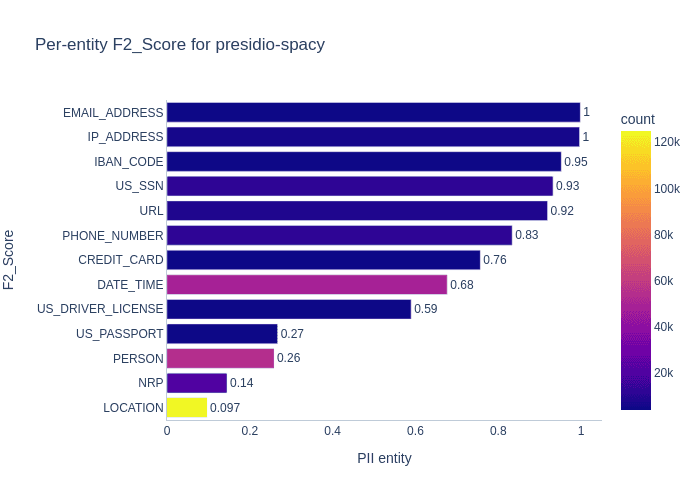
Overall, considering that Presidio was designed for and trained on free text (news articles, phone conversations etc.) it performs remarkably well on our protocol trace dataset. That said, Presidio, specifically its underlying Spacy NER model, performs poorly for three entity types: LOCATION, NRP and PERSON. Why does Spacy struggle here? Let's take a look at some of the most frequently misclassified tokens.
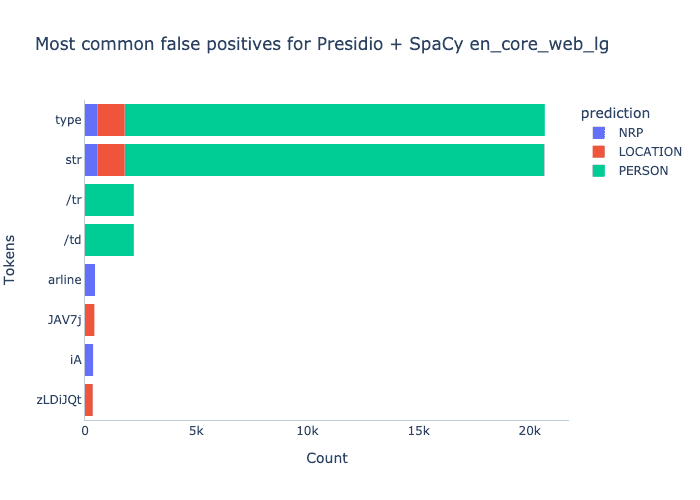
Looking at common false positives, we can see that Spacy hones in on tokens like type str and /td, which are common in html and xml, likely because the model hasn’t seen this kind of protocol trace data before.
What about false negatives? Judging from the word cloud below, we can see that Spacy struggles to identify common location-related keywords, probably because they are embedded in protocol trace data instead of the free text this model was trained on.
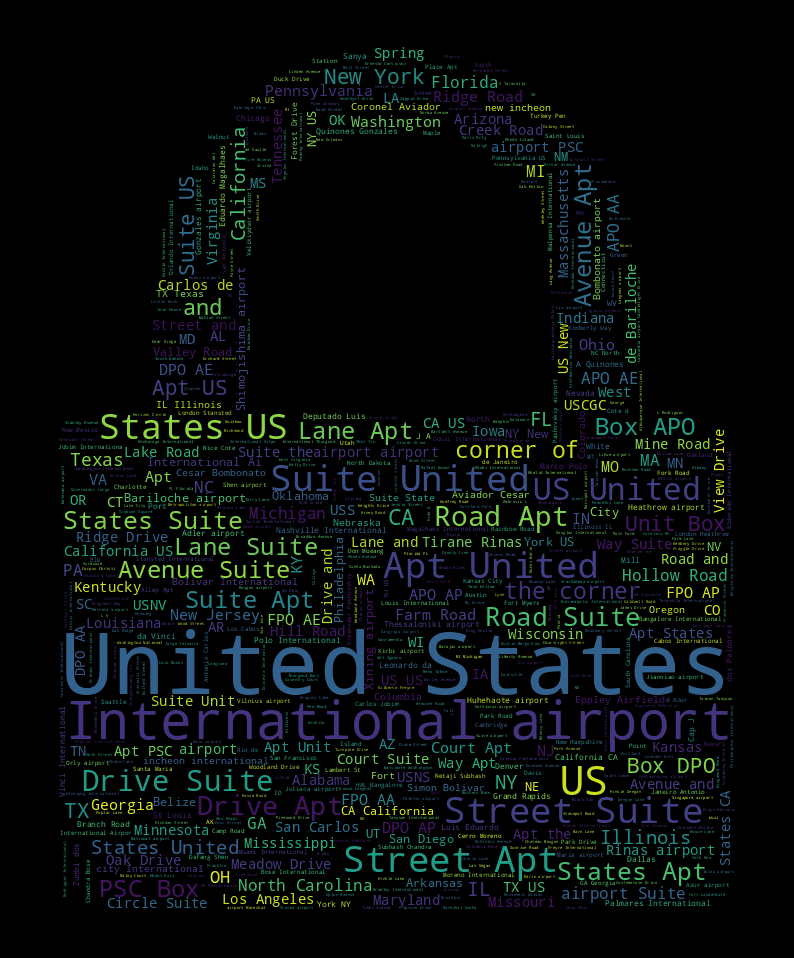
How is Flair different from Presidio Analyzer? For our purposes, the primary difference is that it supports one more PII entity out-of-the-box: ORG (organizations). I have benchmarked flair-ner-english-large, a NER model that uses transformer embeddings and has entity labels similar to Privy.
We can see that Flair performs significantly better than the Spacy NER model for PERSON and LOC while also reporting decent results for ORG.
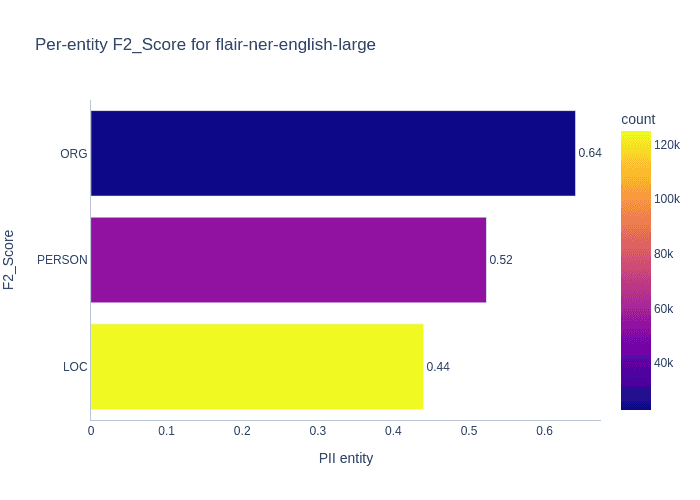
Looking at the most common false positive tokens shows us that Flair, like Spacy, gets confused by html keywords like /td and th.
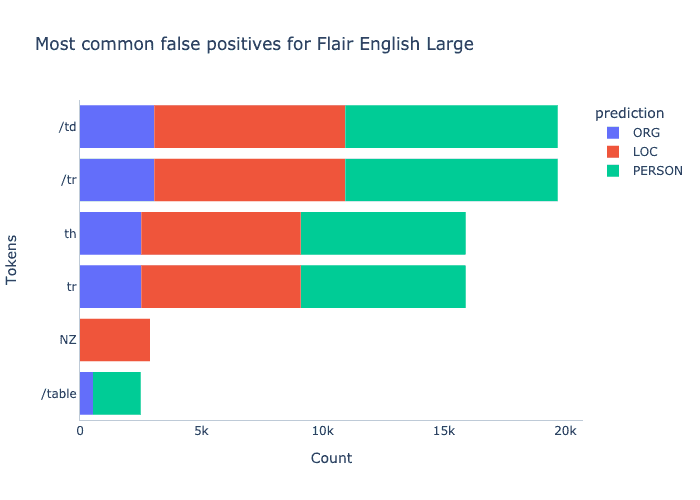
What about false negatives? From the word cloud below, we see that Flair struggles with a variety of names, likely because they are contained within protocol traces and not the free text this model was trained on.
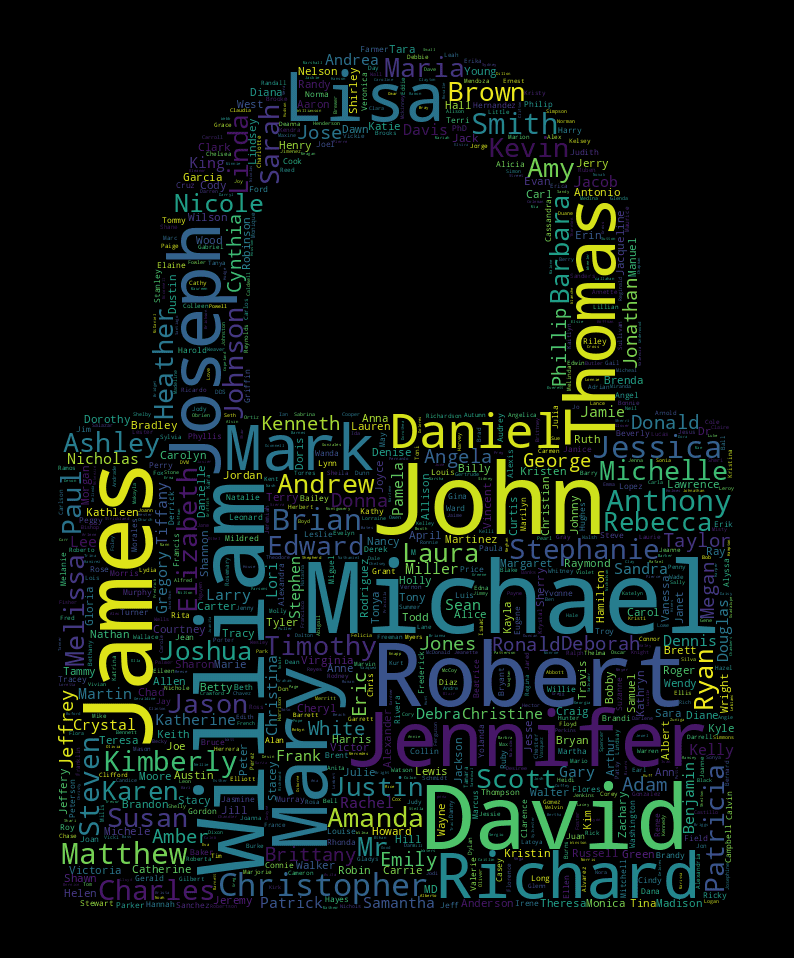
Can we do better than existing classifiers? Let’s train new models and benchmark them on the entities that existing NER models struggle most with in our dataset - PERSON, LOCATION, ORGANIZATION, DATETIME and NRP. I have chosen the following sequence labelling models to train:
- Flair transformer with Distilbert embeddings
- SpaCy 3.4.1 transformer with Distilbert embeddings
- SpaCy 3.4.1 CNN optimized for accuracy on CPU
- SpaCy 3.4.1 CNN optimized for efficiency on CPU
To improve data coverage, I have added three additional labelled datasets to my training data: CONLL (news articles), WikiGold (wikipedia text), and OntoNotes (various genres of free text). Finally, to reduce training time, I have used only 20% of Privy’s synthetic dataset, which amounts to 120k unique samples. See the graph below for F2 scores on a test set pooled from all data sources.

Okay, so we’ve improved the PII identification element, but how do we actually redact PII from text? One way is to integrate our custom models with Presidio’s Anonymizer engine. This allows us to use Presidio’s rule-based classifiers for PII it excels at finding (phone numbers, emails etc.) while using our custom model to find the entities Presidio struggles with (LOCATION PERSON, NRP, ORGANIZATION).
Let’s see it in action — this PII anonymizer is hosted on huggingface and on streamlit!

Accuracy is all well and good, but how fast are these models? I have used Spacy’s benchmarking project to measure the average speed of each model in words per second (WPS). We can see that the Spacy model optimized for efficiency on CPU outperforms the rest. It also takes up only 7 MB of space.
| Library | Model | Link | WPS CPU | WPS GPU | Size (MB) |
|---|---|---|---|---|---|
| spaCy | CNN optimized for efficiency on CPU | en_spacy_pii_fast | 24,686 | 26,391 | 7 |
| spaCy | CNN optimized for accuracy on CPU | en_spacy_pii_lg | 4,501 | 6,669 | 608 |
| spaCy | Transformer (Distillbert) | en_spacy_pii_distilbert | 336 | 10,381 | 243 |
| Flair | Transformer (Distillbert) | flair-pii-distilbert | 74 | 944 | 783 |
The nice thing about machine learning is that when we improve the quality of our training data, we tend to improve the accuracy of our ML system regardless of what model architecture we use. As a result, improving the synthetic data generator is the best way to improve PII classifiers for protocol trace data. To achieve this, we could:
- Support additional protocol trace formats, like protobuf. Pixie currently supports a number of protocol trace formats, but not all of them are generated by Privy.
- Improve the realism of PII and non-PII data providers.
- Implement country specific data generators to support more languages and regions.
Benjamin Kilimnik is an undergraduate at Brown University. You can connect with him on LinkedIn.
Terms of Service|Privacy Policy
We are a Cloud Native Computing Foundation sandbox project.
Pixie was originally created and contributed by New Relic, Inc.
Copyright © 2018 - The Pixie Authors. All Rights Reserved. | Content distributed under CC BY 4.0.
The Linux Foundation has registered trademarks and uses trademarks. For a list of trademarks of The Linux Foundation, please see our Trademark Usage Page.
Pixie was originally created and contributed by New Relic, Inc.


